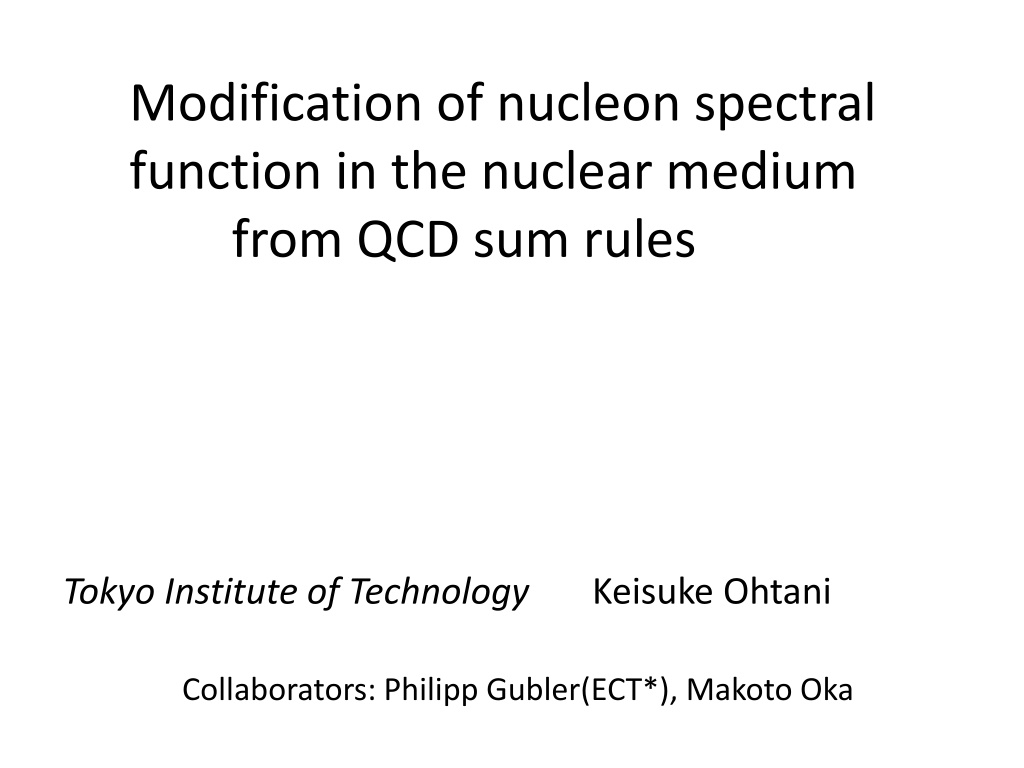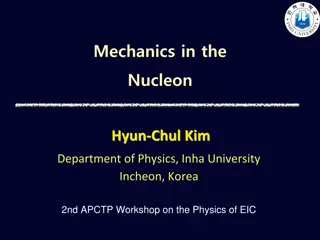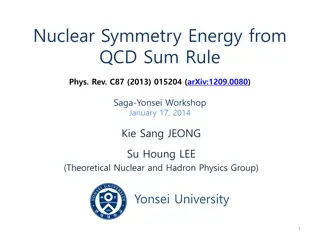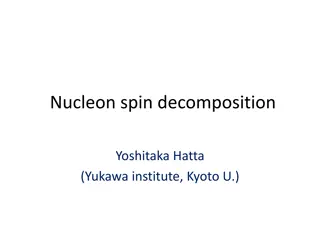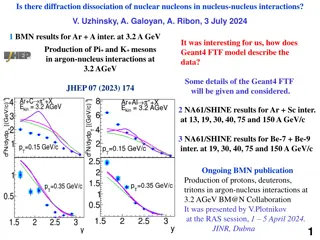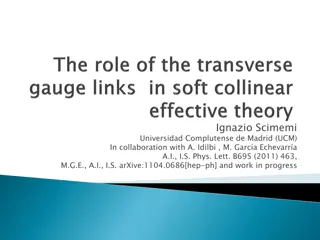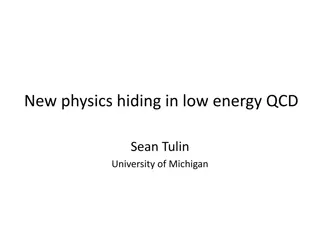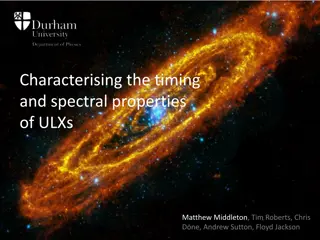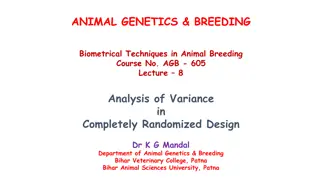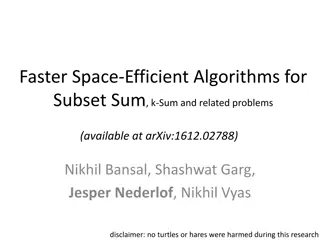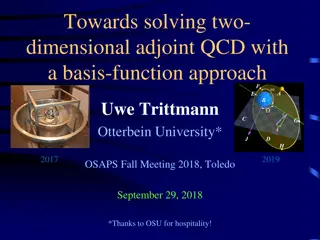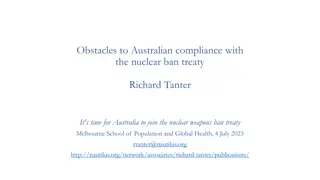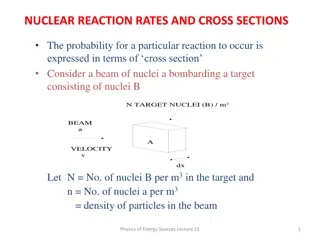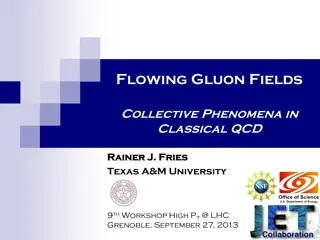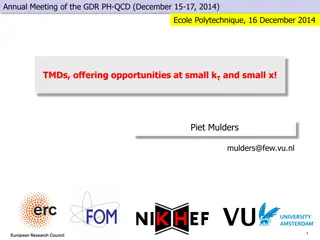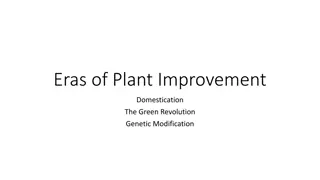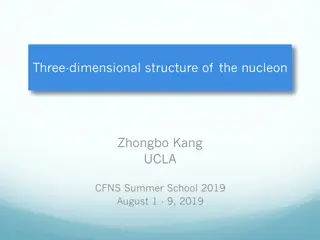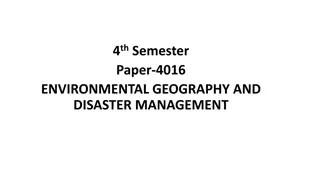Modification of Nucleon Spectral Function in Nuclear Medium from QCD Sum Rules
Investigating the modification of nucleon properties in the nuclear medium using QCD sum rules, focusing on hadron properties, mass spectrum, and chiral symmetry restoration. The study discusses the mass differences, non-perturbative contributions, and the analysis of QCD sum rule in nuclear matter. The application of operator product expansion and condensates in determining hadronic spectral functions in both vacuum and nuclear matter is explored.
Download Presentation

Please find below an Image/Link to download the presentation.
The content on the website is provided AS IS for your information and personal use only. It may not be sold, licensed, or shared on other websites without obtaining consent from the author. Download presentation by click this link. If you encounter any issues during the download, it is possible that the publisher has removed the file from their server.
E N D
Presentation Transcript
Modification of nucleon spectral function in the nuclear medium from QCD sum rules Tokyo Institute of Technology Keisuke Ohtani Collaborators: Philipp Gubler(ECT*), Makoto Oka
Outline Introduction QCD sum rules Nucleon QCD sum rule in vacuum Nucleon QCD sum rule in nuclear matter Summary
Introduction Hadron properties in the nuclear medium Probe hadron N N N N N N The properties of the hadron are modified in the medium. N N N N N Partial restoration of the chiral symmetry Nuclear matter Interaction with the nucleons in the nuclear matter We focus on the nucleon ground state and its negative parity excited state.
Introduction Mass spectrum of the nucleons Positive parity Negative parity N(1650) N(1535) N(1440) p, n
Introduction Mass spectrum of the nucleons Positive parity Negative parity N(1650) N(1535) The mass difference between nucleon ground state and N(1535) is about 600 MeV. N(1440) It is predicted that Chiral symmetry breaking cause these difference. p, n
Introduction Mass spectrum of the nucleons Positive parity Negative parity N(1650) In the nuclear matter The mass difference between nucleon ground state and N(1535) is about 600 MeV. N(1535) The mass difference between nucleon ground state and N(1535) is about 600 MeV. N(1440) It is predicted that Chiral symmetry breaking cause these difference. p, n When chiral symmetry is restored, the mass spectrum will change. To investigate these properties from QCD, non perturbative method is needed. Analysis of QCD sum rule in nuclear matter
QCD sum rules Hadronic spectral function is calculated by the operator product expansion (OPE) Non perturbative contributions are expressed by some Condensates. , An order parameter of chiral symmetry Application of the analyses in the nuclear matter.
QCD sum rules Nuclear matter Vacuum Ground state of nuclear matter Probe hadron Probe hadron N N N N N N N N N N N In vacuum In nuclear matter
QCD sum rules Nuclear matter Vacuum Ground state of nuclear matter Probe hadron Probe hadron N N N N N N N N N N N In vacuum In nuclear matter Modification: Chiral condensate New condensate:
QCD sum rules Nuclear matter Vacuum is calculated by OPE Transformation Gaussian sum rule s: parameter OPE side We extract the information on the spectral function with maximum entropy method (MEM).
Nucleon QCD sum rule in vacuum The behavior of the OPE data in the vacuum contains the term Mass spectrum of the nucleons Parity: + Parity: - Positive parity OPE Negative parity OPE term The difference between positive parity and negative parity is mainly caused by chiral condensate term.
Nucleon QCD sum rule in vacuum Positive parity Negative parity 930MeV 1550 MeV In both positive and negative parity, the peaks are found. In the negative parity state, the peak correspond to the N(1535) or (and) N(1650).
Nucleon QCD sum rule in nuclear matter Ground state of nuclear matter The behavior of the OPE data in the nuclear matter Nuclear matter Vacuum Probe nucleon Probe hadron N N N N N N N N N N N In vacuum In nuclear matter
Nucleon QCD sum rule in nuclear matter The behavior of the OPE data in the nuclear matter Nuclear matter Vacuum Mass spectrum of the nucleons Vacuum Positive parity OPE Parity: + Parity: - Negative parity OPE term term N: nuclear matter density
Nucleon QCD sum rule in nuclear matter The behavior of the OPE data in the nuclear matter contains the term contain the terms Mass spectrum of the nucleons 0.25 N Positive parity OPE Parity: + Parity: - Negative parity OPE term term N: nuclear matter density Positive parity: OPE data decreases. Negative parity: OPE data slightly increases.
Nucleon QCD sum rule in nuclear matter The behavior of the OPE data in the nuclear matter contains the term contain the terms Mass spectrum of the nucleons 0.5 N Positive parity OPE Parity: + Parity: - Negative parity OPE term term N: nuclear matter density Positive parity: OPE data decreases. Negative parity: OPE data slightly increases.
Nucleon QCD sum rule in nuclear matter The behavior of the OPE data in the nuclear matter contains the term contain the terms Mass spectrum of the nucleons 0.75 N Positive parity OPE Parity: + Parity: - Negative parity OPE term term N: nuclear matter density Positive parity: OPE data decreases. Negative parity: OPE data slightly increases.
Nucleon QCD sum rule in nuclear matter The behavior of the OPE data in the nuclear matter contains the term contain the terms Mass spectrum of the nucleons 1.0 N Positive parity OPE Parity: + Parity: - Negative parity OPE term term N: nuclear matter density Positive parity: OPE data decreases. Negative parity: OPE data slightly increases.
Nucleon QCD sum rule in nuclear matter Vacuum Positive parity OPE data Negative parity OPE data term term N : nuclear matter density Negative parity Positive parity : Vacuum : =0.25 0 : =0.5 0 : =0.75 0 : n=n0
Nucleon QCD sum rule in nuclear matter 0.25 N Positive parity OPE data Negative parity OPE data term term N : nuclear matter density Negative parity Positive parity : Vacuum : =0.25 N : =0.5 0 : =0.75 0 : n=n0
Nucleon QCD sum rule in nuclear matter 0.5 N Positive parity OPE data Negative parity OPE data term term N : nuclear matter density Negative parity Positive parity : Vacuum : =0.25 N : =0.5 N : =0.75 0 : n=n0
Nucleon QCD sum rule in nuclear matter 0.75 N Positive parity OPE data Negative parity OPE data term term N : nuclear matter density Negative parity Positive parity Negative parity Positive parity : Vacuum : =0.25 N : =0.5 N : =0.75 N : n=n0 : =1.0 0
Nucleon QCD sum rule in nuclear matter 1.0 N Positive parity OPE data Negative parity OPE data term term N : nuclear matter density Negative parity Positive parity : Vacuum Negative parity Positive parity : =0.25 N : =0.5 N : =0.75 N : n=n0 : =1.0 N The values of the energies are obtained.
Nucleon QCD sum rule in nuclear matter Nuclear matter Vacuum N N N N N N N N N N N N N Probe nucleon Propagator: Propagator: Pole of positive energy state: Effective mass: Pole of negative energy state:
Nucleon QCD sum rule in nuclear matter Investigation of effective masses and vector self energies + (contribution of negative parity states) + q 0 1 2 q 0 1 2 u are calculated by OPE are expressed by the propagators in physical energy region By fitting the phenomenological side and OPE side, we can investigate the self energies.
Nucleon QCD sum rule in nuclear matter N: nuclear matter density Vacuum =0.25 N =0.5 N =0.75 N =1.0 N 930 660 290 810 490 430 640 0 120 270 1460 1430 1410 1550 1510 0 40 110 130 80
Summary We analyze the nucleon spectral function by using QCD sum rules with MEM We find that the difference between the positive and negative parity spectral function is mainly caused by the chiral condensate. The information of not only the ground state but also the negative parity excited state is extracted We apply this method to the analyses in nuclear medium and investigate the effective masses and the vector self-energies. As the density increases, the effective masses decrease and the vector self-energies increase.
